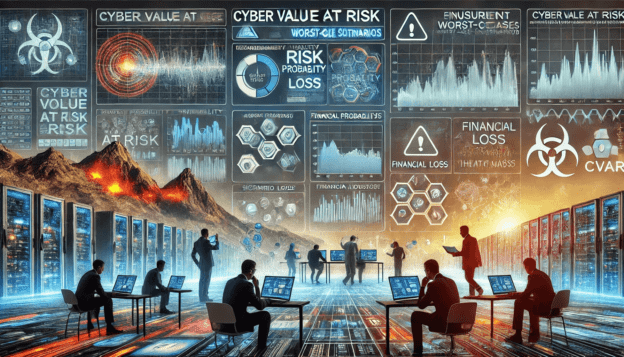Cyber Value at Risk (CVaR) is a powerful methodology adapted from financial Value at Risk (VaR) models, designed to estimate the maximum potential loss from cyber incidents within a given confidence interval. CVaR focuses on worst-case scenarios, helping organisations understand the potential financial consequences of cyber threats and guiding strategic decision-making.
This article explores the principles of CVaR, how it works, and its practical applications, highlighting its role in modern cybersecurity risk management.
Contents
1. The Origins of CVaR
CVaR is rooted in traditional Value at Risk (VaR) models used in finance to measure potential losses in investment portfolios. As cybersecurity threats began to pose significant financial risks, organisations adapted these principles to evaluate the economic impact of cyber incidents.
Key motivations for CVaR’s development:
- Quantifying Uncertainty: Estimate financial exposure to cyber threats.
- Scenario Modelling: Evaluate potential losses across a range of hypothetical incidents.
- Decision Support: Provide actionable insights for executives and boards.
CVaR builds on VaR by focusing on the tail of the risk distribution, capturing the most extreme losses rather than just the expected range.
2. How CVaR Works
CVaR quantifies the financial impact of cyber threats by analysing potential losses under different scenarios and probabilities.
2.1 Key Components:
- Critical Asset Identification: Determine which assets are most valuable and at risk (e.g., customer data, IT infrastructure).
- Scenario Modelling: Simulate potential cyber incidents (e.g., ransomware, DDoS attacks).
- Probabilistic Analysis: Use statistical methods like Monte Carlo simulations to estimate loss probabilities.
- Loss Estimates: Calculate both direct (e.g., data recovery) and indirect (e.g., reputational damage) financial impacts.
2.2 Confidence Intervals:
CVaR estimates the maximum financial loss within a specified confidence level (e.g., 95%).
- Example: “There is a 95% probability that losses from a ransomware attack will not exceed £5 million.”
3. CVaR in Practice
3.1 Scenario Modelling with Monte Carlo Simulations
Monte Carlo simulations generate thousands of possible outcomes for a given cyber scenario, accounting for variability in factors like attack frequency, exploitability, and asset value.
- Example: A financial institution simulates a phishing campaign targeting customer accounts, estimating losses from regulatory fines, customer compensation, and operational downtime.
3.2 Combining CVaR with Other Frameworks
CVaR is often used alongside other methodologies, such as FAIR or NIST CSF, to enhance risk analysis.
- Example: Use FAIR to estimate threat event frequency and CVaR to model worst-case financial outcomes.
4. Applications of CVaR
4.1 Strategic Decision-Making
Executives use CVaR to allocate resources effectively and justify cybersecurity investments.
- Example: A hospital estimates a £10 million CVaR for a ransomware attack, prompting a £500,000 investment in backup systems and staff training.
4.2 Cyber Insurance
Insurers use CVaR to assess premiums and determine coverage limits based on the client’s worst-case loss scenarios.
- Example: An e-commerce company’s CVaR analysis shows potential losses of £8 million, influencing the insurer’s policy terms and pricing.
4.3 Regulatory Compliance
CVaR helps organisations meet regulatory requirements by demonstrating preparedness for high-impact risks.
- Example: Under the EU Digital Operational Resilience Act (DORA), financial institutions use CVaR to assess systemic cyber risks.
5. Advantages of CVaR
- Focus on Worst-Case Scenarios: Captures extreme losses, ensuring readiness for high-impact events.
- Quantifiable Insights: Provides precise financial estimates to support risk management.
- Scenario Flexibility: Can model diverse threats, from ransomware to insider attacks.
6. Limitations of CVaR
- Data Dependence: Requires accurate data on asset value, threat probabilities, and historical incidents.
- Complexity: Monte Carlo simulations and statistical modelling demand specialised expertise.
- Focus on Tails: While useful for worst-case scenarios, CVaR may overlook more probable, smaller-scale risks.
7. The Future of CVaR
CVaR is likely to evolve alongside advancements in cybersecurity and risk analytics:
- AI Integration: Machine learning models could enhance the precision of scenario simulations.
- Real-Time Risk Assessment: Incorporating threat intelligence to update CVaR estimates dynamically.
- Sector-Specific Models: Customising CVaR frameworks for industries like healthcare, finance, and critical infrastructure.
Conclusion
Cyber Value at Risk (CVaR) provides organisations with a robust methodology for understanding the financial implications of cyber threats. By focusing on worst-case scenarios, CVaR enables executives and boards to prepare for high-impact events, allocate resources wisely, and demonstrate resilience to stakeholders. As cyber risks grow in complexity, CVaR’s role in strategic decision-making and regulatory compliance will continue to expand.
